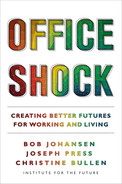ABOUT THE RESEARCH
At the height of the first COVID-19 wave, the Institute for the Future (IFTF) received a call from Colin Macgadie, creative director of the architectural firm BDG. One of BDG’s clients, the Swiss-based furniture company USM, was looking for a partner to forecast the future of the workplace.
A few weeks later, Bob and Joseph spoke with USM’s CEO Alex Schärer. Alex was indeed interested in increasing his clarity about the future of the workplace. More importantly though, he wanted to start a new conversation about the workplace and its role in society.
The IFTF team mobilized a diverse research team and enlisted Christine as coauthor to explore the future of the workplace. Just as the research began, African American George Floyd Jr. was murdered by a white police officer in Minneapolis. Sixteen months later, world leaders fell short of agreement on climate change at COP26 in Glasgow. These events, and the ongoing pandemic, expanded our research beyond the workplace. Our work revealed what IFTF forecasted after the pandemic, what our colleagues call the deeper diseases (iftf.org/whathappensnext/).
With Alex’s objective of triggering an in-depth conversation, Bob and Joseph shared the research at a meeting of global CEOs in Switzerland. Office shock did indeed trigger a deeper conversation, and in the C-suite no less. A few months later a group of architects, futurists, and leadership experts came together for a virtual symposium to stress test the research. Once again, office shock was a catalyst for opening constructive conversations. With this group’s feedback, and additional feedback from our conceptual editor Steve Piersanti, we wrote Office Shock.
Our purpose is to provide provocative stories from the future that provoke your thought. We are not experts in the present. We are not here to predict the future (nobody can do that), but we are writing this book to provoke creative thought about the future of distributed work. We have all been thinking futureback for decades but in very different ways. Bob’s career has focused on the intersection of technology, organizations, and humans. Joseph designed offices early in his architecture and consulting career and then focused on digital transformation. Christine has viewed the future through information technology and communications. Together we have a broad, colorful, and varied experience with the future of working and living.
Our goal is to create a framework for choice-making about offices and officing. We are writing for individuals, organizations, and policy makers. We are not here to tell you what to do, but we do include our assessments and recommendations—particularly in part III on making smart choices—given the external future forces of the next decade.
To amplify and expand conversations about the future of the office, we invited a group of diverse artists from across the globe to illustrate our future scenarios. We hope the illustrations help our readers to imagine the future and prepare for the futures they choose. We don’t predict the future. Our goal in this book is to empower people, organizations, and society to create better ways of working and living.
Throughout the writing our conversations have been incredibly rich. We have learned immensely from each other, even agreeing to disagree on occasion. We have learned from the plethora of experts writing about these topics. This book is built on their shoulders as well as ours. We’ve done our best to increase the clarity amid the complexity but acknowledge that surely we have missed much along the way.
Our hope is that with this book we have achieved Alex’s vision of triggering a deeper and diverse conversation about creating better futures for working and living. We invite you to share your stories and join our ongoing conversation exploring office shock at www.officeshock.org.
